2019 Versys 1000 test: (r) evolutions for the Kawasaki GT Maxitrail
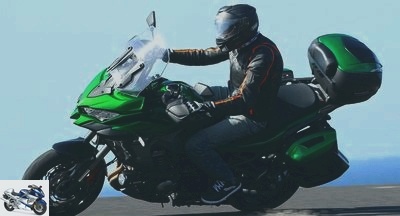
The Versys 1000 undergoes a new stylistic evolution in 2019. Launched in 2012 and remodeled in 2015, the trail – very – road Kawasaki is also making its digital revolution, in particular with its new SE version with electronic suspensions. MNC tested it equipped with its Grand Tourer pack. Full test.
2019 Versys 1000 test page 4: Technical point
Engine
Versys 1000’s architecture and engine size are enough for Greens fans from St-Etienne Akashi to know its origin: 4-cylinder 1043 cc, bore and stroke 77 x 56 mm? All immediately recognize the signature of the Z1000 released in 2010 !
For 2019 and on this new model, the mill – water – receives an update mainly electronic. It inaugurates a new wireless accelerator. Without any cables! Kawasaki underlines in fact that its ETV system for "Electronic Throttle Valve" is the first to incorporate the position sensor (potentiometer) directly into the handle..
"Eliminating the throttle cable simplifies maintenance", congratulate the Japanese, who have taken care at the same time, "to ensure a natural feeling, to simulate the friction of the cable in its sheath. The injection programming is refined" especially for maneuvers at low and mid speed and when the throttle is cut ".
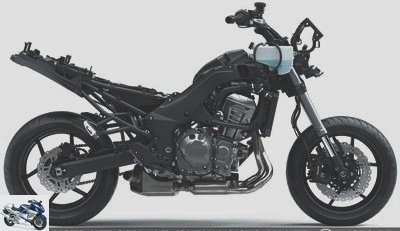
From a mechanical point of view, the exhaust has only been revised. The tubes connecting the collectors (1 and 4 on the one hand, 2 and 3 on the other) abandon their oval cut in favor of a round cut supposed to "contribute to improving performance at all speeds".
By taking a look at the technical sheet (on the next page), MNC notices however that the maximum values of the Kawasaki maxitrail maxiroutier do not vary between the 2015 and 2019 model: 120 hp at 9000 rpm and 102 Nm at 7,500 rpm, while the full weight is up by three kilograms (253 kg for the standard, 257 kg for the SE).
The silencer becomes a bit shorter and sharper. A three-way catalyst placed under the engine ensures compliance with the current antipollution standard (Euro4). The rest of the engine block from 2015 is preserved: Kawa recalls the particular presence of a balancing pendulum to limit – but not eliminate in the turns, unfortunately – the vibrations of the 4-legged.
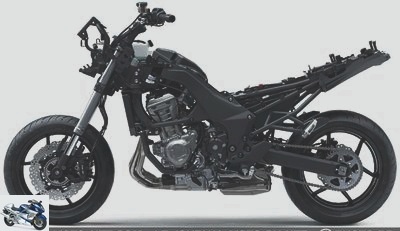
The limited-slip assisted clutch is still present, supported on the SE version of a two-way "Kawasaki Quick Shifter" (KQS): it not only allows upshifts without touching the clutch and regardless of the speed. opening of the throttle, but also to lower them (gas cut).
With the same goal of simplifying the life of the biker – and to try to lengthen that of his driving license! -, Kawasaki equips its Versys 1000 (2019 model, with or without SE) as standard with cruise control. Placed on the left, the controls allow you to easily select your cruising speed and then adjust it as needed.
The engine retains its two power modes: F as "Full" and L as "Low" which restricts the maximum power to approximately 75% (approximately 90 hp therefore) and moderates the throttle response according to the engine speed, the position of the handle and gear engaged.
Part-cycle
The chassis also changes for 2019: the tubular aluminum frame is kept as it is, but the suspensions – quite – long travel see their settings revised in order to increase driving comfort. The shock absorber links are also redesigned, for the same purpose.
The new "SE" version receives electronically controlled suspensions (KECS): a 43 mm Showa fork similar to that mounted on the Ninja ZX-10R SE at the front, and the latest generation of Showa BFRC shock absorbers. with the suffix "lite" (for light, therefore more efficient!?) at the back.
The trail allows itself to do better than the Superbike, since its rear preload is electronically adjustable: three modes are preset (solo, solo with luggage, or duo with luggage). Simpler than the remote dial … and just as reliable over time? Kawasaki guarantees it.
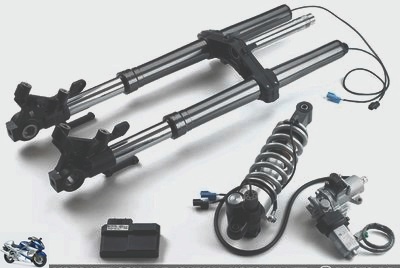
For greater simplicity, the hydraulics of the electronic suspensions are automatically adapted to the driving modes selected by the user: Sport, Road, Rain or Rider. These modes also modify the traction control and the engine mode accordingly (see table below).
In Rider mode, the pilot sets his electronic suspensions more finely and entirely by hand: he accesses the three default suspension settings (Hard, Normal or Soft) and can open or close the hydraulics by more or less five notches. It can also disconnect the traction control. But here we are moving away from the chassis to anticipate the electronic part.
The 2019 Versys gives way to the fashion of monobloc radial calipers … that Kawasaki took from the bodies of the last Z1000! The four pistons (32 mm at the top, 30 mm in abs) pinch the same 310 mm disc with petals. The radial master cylinder should help improve the feel of the lever, its smoked jar should embellish the cockpit. The rear brake is renewed in its functions.
Electronic
The Versys 1000 – "quite short" like SE – is equipped for 2019 with an inertial unit. This Bosch original IMU allows Japanese engineers to fine-tune traction control (KTRC) and anti-lock braking (KIBS) taking into account the position and movements of the motorcycle … This tiny box (40 gr) hears avoid heavy falls.
When braking, the "Kawasaki Intelligent anti-lock Brake System" not only monitors the speed of rotation of each wheel – "like all basic ABS", recalls Kawasaki – but also takes into account the pressure subjected to the front calipers, the position of the throttle grip, engine speed, clutch and gear engaged.
With the arrival of the IMU, it also detects the angle and the attitude of the motorcycle and acts accordingly: "if the rider must use the brakes after entering a curve or in the middle of a turn, the braking force is modulated to counter the tendency of the motorcycle to stand up "… in the dry, or to slide in the wet !
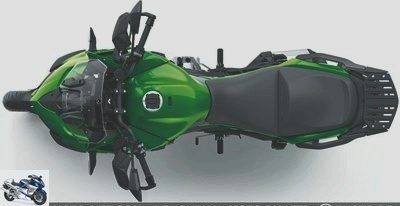
When accelerating, the "Kawasaki TRaction Control" takes over, offering three levels of intervention. The first (1) prioritizes performance and grants a certain degree of rear wheel slip or front wheel lift, regulating engine power via micro-ignition and power management..
Modes 2 then 3 act in the same way but are more and more intrusive. If necessary, the ignition can be delayed in order to "reduce the power and allow you to regain grip". Good to know: the mode chosen is retained even after switching off the ignition. It is possible to disconnect the KTRC (Rider mode), but mode 1 is selected by default at the next start.
On the “SE”, engine power, traction control and suspension settings are combined in selectable ride modes – on the go – via handlebar controls. The information is displayed on a TFT color screen which offers two types of display: the first is very complete, the second copy and paste that of the Ninja H2 SX (it is its screen originally).
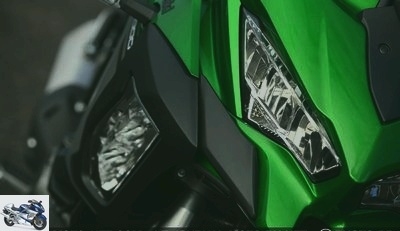
The Versys 1000 SE also stings from the supercharged road its curved lighting, made up of two sets of three LEDs which light up gradually as the motorcycle takes an angle. This system completes the "Ful LED" equipment: headlights, lights and indicators.
Finally, Kawasaki has developed an application "Rideology The App" allowing you to connect your motorcycle to your smartphone: "an iPhone from today, an Android very soon", tell us the green men … apple? The motorcycle can thus warn its user that he receives a call or an email.
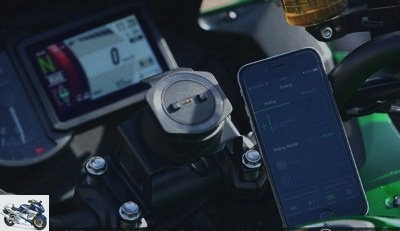
Conversely, vehicle information (odometer, trips, fuel and battery level, workshop appointments, etc.), trip reports (routes, duration, speed, angles, acceleration, braking, etc!) can be found at your fingertips.
Likewise, the settings of the suspensions or the driving modes can be done directly on his "smart phone", which avoids the less obvious handling of the controls on the handlebars. When will the update including a "chain lubrication" function? ?
Related articles
-
2019 Versys 1000 test: (r) evolutions for the Kawasaki GT Maxitrail The Versys 1000 undergoes a new stylistic evolution in 2019. Launched in 2012 and…
-
2019 Versys 1000 test: (r) evolutions for the Kawasaki GT Maxitrail The Versys 1000 undergoes a new stylistic evolution in 2019. Launched in 2012 and…
-
2019 Tuono V4 1100 Factory test: electrostimulation for the Aprilia roadster The Tuono V4 1100 is undergoing a new evolution in 2019: its…
-
2019 Versys 1000 test: (r) evolutions for the Kawasaki GT Maxitrail The Versys 1000 undergoes a new stylistic evolution in 2019. Launched in 2012 and…
-
All Tests – Versys 1000 test: the Kawasaki trail almost on target! – A formidable trail on the road
Versys 1000 test: the Kawasaki trail almost on target ! Derived from the fierce Z1000, the maxi trail Versys 1000 radicalises the concept of the Versys…
-
Test Triumph Tiger 1200 XRT and XCA 2018: ready for the road adventure Electric window, keyless start, hill start assistant, directional lights,…
-
2020 Z900 test: Kawasaki returns to its Nine-without-aids Successfully launched in 2017, the Kawasaki Z900 evolves in 2020: the roadster changes music…
-
Tiger Explorer XCA test : Triumph at a crossroads Electric screen, semi-active suspensions, hill start aid, high-tech ABS and anti-skidding: so many…
-
2017 Suzuki GSX- R1000R review: the beauty of Gex Driven by the most recent hypersport motorcycles for lack of developments in the last ten years or so,…
-
All Tests – Versys 1000 test: the Kawasaki trail almost on target! – A Versys XL for 2012
Versys 1000 test: the Kawasaki trail almost on target ! Derived from the fierce Z1000, the maxi trail Versys 1000 radicalizes the concept of the Versys…